New Testament 1522
33.9 x 23.8 cm (book measurement (conservation)) | RCIN 1052035
![Novum Testamentum omne . . . cum annotationibus recognitis . . . / [edited by] Erasmus Novum Testamentum omne . . . cum annotationibus recognitis . . . / [edited by] Erasmus](https://col.rct.uk/sites/default/files/styles/rctr-scale-1300-500/public/collection-online/0/5/146583-1297436548.jpg?itok=gRChEw5m)
Desiderius Erasmus (1466-1536)
Novum Testamentum omne . . . cum annotationibus recognitis . . . / [edited by] Erasmus 1522
![Novum Testamentum omne . . . cum annotationibus recognitis . . . / [edited by] Erasmus Novum Testamentum omne . . . cum annotationibus recognitis . . . / [edited by] Erasmus](https://col.rct.uk/sites/default/files/styles/rctr-scale-1300-500/public/collection-online/9/4/146581-1297436547.jpg?itok=OIXsH8g4)
Desiderius Erasmus (1466-1536)
Novum Testamentum omne . . . cum annotationibus recognitis . . . / [edited by] Erasmus 1522
![Novum Testamentum omne . . . cum annotationibus recognitis . . . / [edited by] Erasmus Novum Testamentum omne . . . cum annotationibus recognitis . . . / [edited by] Erasmus](https://col.rct.uk/sites/default/files/styles/rctr-scale-1300-500/public/collection-online/4/5/146576-1297436545.jpg?itok=Vy3PhjkO)
Desiderius Erasmus (1466-1536)
Novum Testamentum omne . . . cum annotationibus recognitis . . . / [edited by] Erasmus 1522
![Novum Testamentum omne . . . cum annotationibus recognitis . . . / [edited by] Erasmus Novum Testamentum omne . . . cum annotationibus recognitis . . . / [edited by] Erasmus](https://col.rct.uk/sites/default/files/styles/rctr-scale-1300-500/public/collection-online/e/7/146577-1297436545.jpg?itok=iSy73VKN)
Desiderius Erasmus (1466-1536)
Novum Testamentum omne . . . cum annotationibus recognitis . . . / [edited by] Erasmus 1522
![Novum Testamentum omne . . . cum annotationibus recognitis . . . / [edited by] Erasmus Novum Testamentum omne . . . cum annotationibus recognitis . . . / [edited by] Erasmus](https://col.rct.uk/sites/default/files/styles/rctr-scale-1300-500/public/collection-online/f/3/146580-1297436546.jpg?itok=0FbctjqL)
Desiderius Erasmus (1466-1536)
Novum Testamentum omne . . . cum annotationibus recognitis . . . / [edited by] Erasmus 1522
![Novum Testamentum omne . . . cum annotationibus recognitis . . . / [edited by] Erasmus Novum Testamentum omne . . . cum annotationibus recognitis . . . / [edited by] Erasmus](https://col.rct.uk/sites/default/files/styles/rctr-scale-1300-500/public/collection-online/8/b/146582-1297436547.jpg?itok=gM8bEGE_)
Desiderius Erasmus (1466-1536)
Novum Testamentum omne . . . cum annotationibus recognitis . . . / [edited by] Erasmus 1522
![Novum Testamentum omne . . . cum annotationibus recognitis . . . / [edited by] Erasmus Novum Testamentum omne . . . cum annotationibus recognitis . . . / [edited by] Erasmus](https://col.rct.uk/sites/default/files/styles/rctr-scale-1300-500/public/collection-online/8/b/146578-1297436546.jpg?itok=eIzJwo6U)
Desiderius Erasmus (1466-1536)
Novum Testamentum omne . . . cum annotationibus recognitis . . . / [edited by] Erasmus 1522
![Novum Testamentum omne . . . cum annotationibus recognitis . . . / [edited by] Erasmus Novum Testamentum omne . . . cum annotationibus recognitis . . . / [edited by] Erasmus](https://col.rct.uk/sites/default/files/styles/rctr-scale-1300-500/public/collection-online/0/2/257724-1330625425.jpg?itok=K9kyn3la)
Desiderius Erasmus (1466-1536)
Novum Testamentum omne . . . cum annotationibus recognitis . . . / [edited by] Erasmus 1522
![Novum Testamentum omne . . . cum annotationibus recognitis . . . / [edited by] Erasmus Novum Testamentum omne . . . cum annotationibus recognitis . . . / [edited by] Erasmus](https://col.rct.uk/sites/default/files/styles/rctr-scale-1300-500/public/collection-online/1/c/257726-1330625429.jpg?itok=r0VUgBei)
Desiderius Erasmus (1466-1536)
Novum Testamentum omne . . . cum annotationibus recognitis . . . / [edited by] Erasmus 1522
![Novum Testamentum omne . . . cum annotationibus recognitis . . . / [edited by] Erasmus Novum Testamentum omne . . . cum annotationibus recognitis . . . / [edited by] Erasmus](https://col.rct.uk/sites/default/files/styles/rctr-scale-1300-500/public/collection-online/6/e/257722-1330625420.jpg?itok=z66g3vXO)
Desiderius Erasmus (1466-1536)
Novum Testamentum omne . . . cum annotationibus recognitis . . . / [edited by] Erasmus 1522
![Novum Testamentum omne . . . cum annotationibus recognitis . . . / [edited by] Erasmus Novum Testamentum omne . . . cum annotationibus recognitis . . . / [edited by] Erasmus](https://col.rct.uk/sites/default/files/styles/rctr-scale-1300-500/public/collection-online/e/f/257728-1330625433.jpg?itok=MOpY30r1)
Desiderius Erasmus (1466-1536)
Novum Testamentum omne . . . cum annotationibus recognitis . . . / [edited by] Erasmus 1522
![Novum Testamentum omne . . . cum annotationibus recognitis . . . / [edited by] Erasmus Novum Testamentum omne . . . cum annotationibus recognitis . . . / [edited by] Erasmus](https://col.rct.uk/sites/default/files/styles/rctr-scale-1300-500/public/collection-online/4/8/257731-1330625437.jpg?itok=CyokEIQD)
Desiderius Erasmus (1466-1536)
Novum Testamentum omne . . . cum annotationibus recognitis . . . / [edited by] Erasmus 1522
![Novum Testamentum omne . . . cum annotationibus recognitis . . . / [edited by] Erasmus Novum Testamentum omne . . . cum annotationibus recognitis . . . / [edited by] Erasmus](https://col.rct.uk/sites/default/files/styles/rctr-scale-1300-500/public/collection-online/4/3/257736-1330625450.jpg?itok=jcKMgbGr)
Desiderius Erasmus (1466-1536)
Novum Testamentum omne . . . cum annotationibus recognitis . . . / [edited by] Erasmus 1522
![Novum Testamentum omne . . . cum annotationibus recognitis . . . / [edited by] Erasmus Novum Testamentum omne . . . cum annotationibus recognitis . . . / [edited by] Erasmus](https://col.rct.uk/sites/default/files/styles/rctr-scale-1300-500/public/collection-online/c/f/257733-1330625442.jpg?itok=KRkqBZYu)
Desiderius Erasmus (1466-1536)
Novum Testamentum omne . . . cum annotationibus recognitis . . . / [edited by] Erasmus 1522
![Novum Testamentum omne . . . cum annotationibus recognitis . . . / [edited by] Erasmus Novum Testamentum omne . . . cum annotationibus recognitis . . . / [edited by] Erasmus](https://col.rct.uk/sites/default/files/styles/rctr-scale-1300-500/public/collection-online/6/f/257735-1330625445.jpg?itok=YWTb2L2h)
Desiderius Erasmus (1466-1536)
Novum Testamentum omne . . . cum annotationibus recognitis . . . / [edited by] Erasmus 1522
![Novum Testamentum omne . . . cum annotationibus recognitis . . . / [edited by] Erasmus Novum Testamentum omne . . . cum annotationibus recognitis . . . / [edited by] Erasmus](https://col.rct.uk/sites/default/files/styles/rctr-scale-1300-500/public/collection-online/7/1/146584-1297436548.jpg?itok=6hmJXYKp)
Desiderius Erasmus (1466-1536)
Novum Testamentum omne . . . cum annotationibus recognitis . . . / [edited by] Erasmus 1522
![Novum Testamentum omne . . . cum annotationibus recognitis . . . / [edited by] Erasmus Novum Testamentum omne . . . cum annotationibus recognitis . . . / [edited by] Erasmus](https://col.rct.uk/sites/default/files/styles/rctr-scale-1300-500/public/collection-online/4/d/206202-1316601645.jpg?itok=m9WTqiA0)
Desiderius Erasmus (1466-1536)
Novum Testamentum omne . . . cum annotationibus recognitis . . . / [edited by] Erasmus 1522
![Novum Testamentum omne . . . cum annotationibus recognitis . . . / [edited by] Erasmus Novum Testamentum omne . . . cum annotationibus recognitis . . . / [edited by] Erasmus](https://col.rct.uk/sites/default/files/styles/rctr-scale-1300-500/public/collection-online/1/0/206201-1316601643.jpg?itok=4JX95EUZ)
Desiderius Erasmus (1466-1536)
Novum Testamentum omne . . . cum annotationibus recognitis . . . / [edited by] Erasmus 1522
![Novum Testamentum omne . . . cum annotationibus recognitis . . . / [edited by] Erasmus Novum Testamentum omne . . . cum annotationibus recognitis . . . / [edited by] Erasmus](https://col.rct.uk/sites/default/files/styles/rctr-scale-1300-500/public/collection-online/6/4/206203-1316601647.jpg?itok=620Ldztp)
Desiderius Erasmus (1466-1536)
Novum Testamentum omne . . . cum annotationibus recognitis . . . / [edited by] Erasmus 1522
![Novum Testamentum omne . . . cum annotationibus recognitis . . . / [edited by] Erasmus Novum Testamentum omne . . . cum annotationibus recognitis . . . / [edited by] Erasmus](https://col.rct.uk/sites/default/files/styles/rctr-scale-1300-500/public/collection-online/6/c/206204-1316601650.jpg?itok=4LnOBNTX)
Desiderius Erasmus (1466-1536)
Novum Testamentum omne . . . cum annotationibus recognitis . . . / [edited by] Erasmus 1522
![Novum Testamentum omne . . . cum annotationibus recognitis . . . / [edited by] Erasmus Novum Testamentum omne . . . cum annotationibus recognitis . . . / [edited by] Erasmus](https://col.rct.uk/sites/default/files/styles/rctr-scale-1300-500/public/collection-online/4/4/206206-1316601654.jpg?itok=YLBWO_wc)
Desiderius Erasmus (1466-1536)
Novum Testamentum omne . . . cum annotationibus recognitis . . . / [edited by] Erasmus 1522


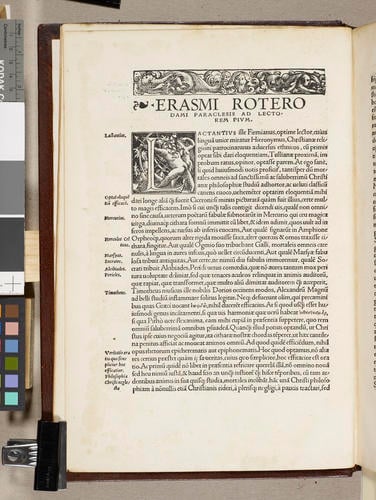

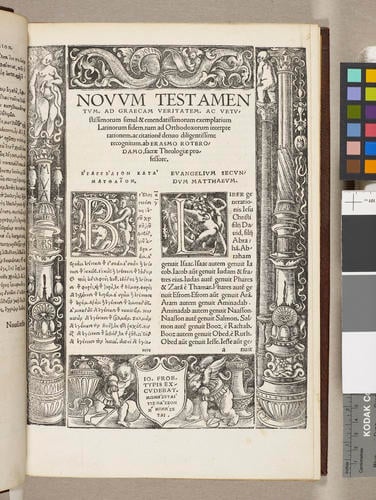


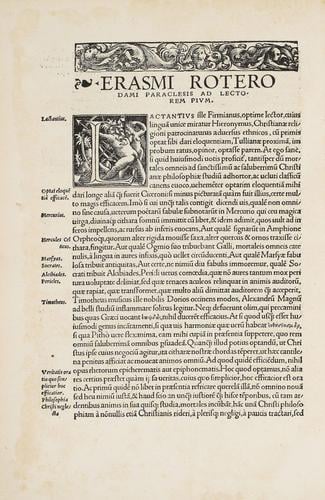
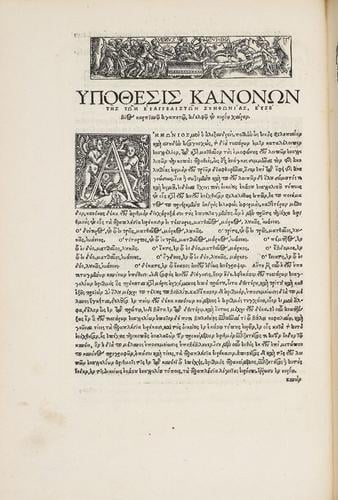
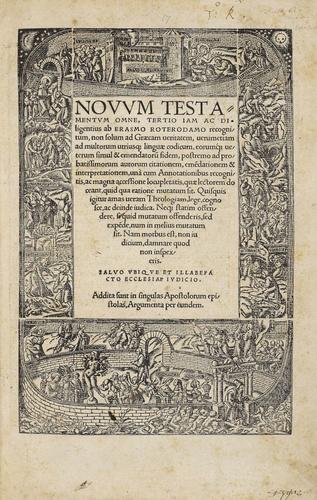

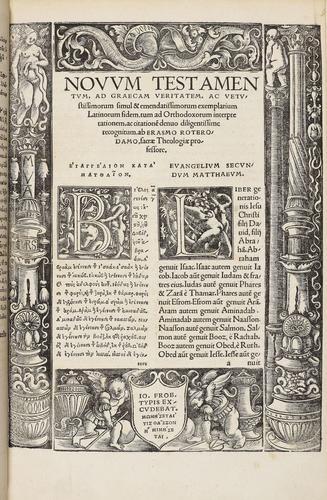
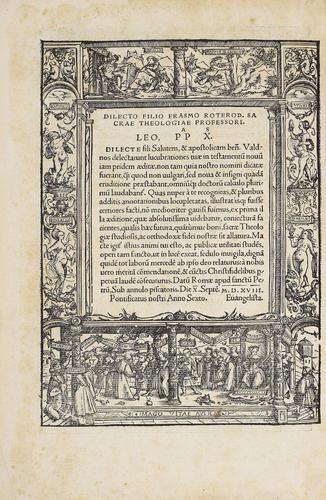
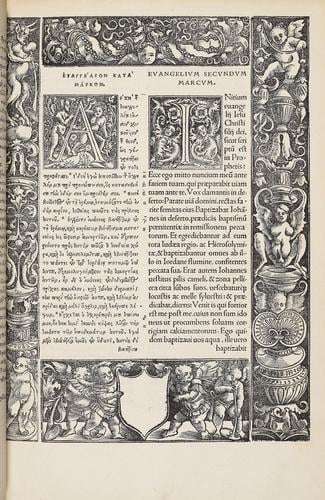
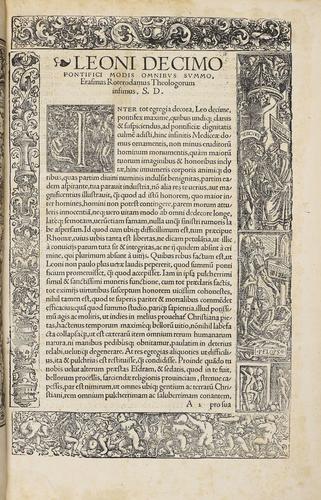
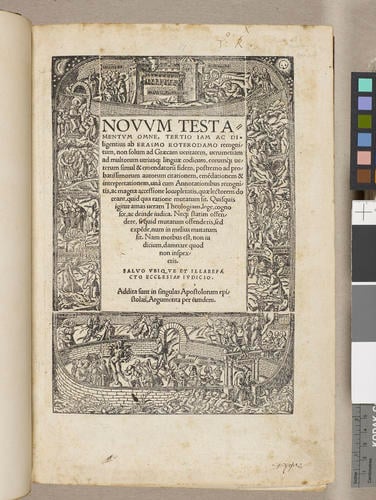


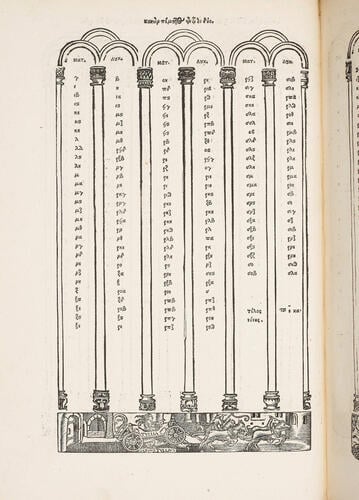
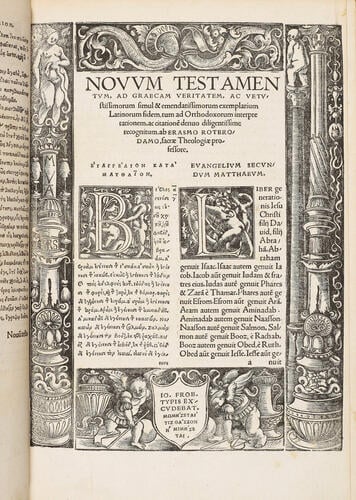


-
Erasmus’s published editions of the New Testament, based for the first time on the Greek originals, were prime examples of humanist philological and critical methods of approaching texts, which had been developing since the fourteenth century. His first edition, Novum Instrumentum (‘New Instrument’), published by Froben in 1516, incorporated the original Greek text alongside a Latin translation based on the Vulgate (a fourth-century Latin version of the Bible which had become the definitive, authorised text) and Erasmus’s own interpretative Annotations. The second edition, published under the familiar name Novum Testamentum, greatly enlarged the Annotations to include an account of his methodology and editorial process, corrected errors in the original edition, and incorporated a new translation into Latin based on the original Greek, which it was hoped would improve the clarity of the text and remove anachronistic interpretations. This third edition of 1522 was probably the one used by William Tyndale (c. 1494-1536) for the production of his first English edition of the New Testament (first published in Worms in 1526).
Froben’s editions featured designs by both Hans Holbein (1497/8-1543) and Ambrosius Holbein (c. 1494-c. 1519), reusing designs used previously for other works. The title page of this edition of the New Testament shows the so-called 'Tabula Cebetis' (variant C). The 'Tabula' was an allegorical representation of the vices and virtues of human life, supposedly written by Cebes of Thebes (fifth to fourth century BC), one of the circle of Socrates and Plato. Holbein’s original design was cut in metal by Jacob Faber (before 1500-c. 1550), inspired by a woodcut from a 1519 edition of the 'Tabula', and featured four separate panels. At bottom right stands the figure of Genius in the entrance to the allegorical garden of the virtues and vices, with the naked figure of winged Fortuna (Fortune) to the left, while at the top of the page sits the enthroned figure of Felicitas (Success, Good Luck). The design came in four variants, known as 'Tabula Cebetis' A, B, C and D. A and C are metalcuts by Faber after Holbein’s original design (C having its bottom segment increased in height in order to deal with a decreased amount of text space), while B and D are woodcuts, probably by Hans Herman (active c. 1516). A, B and C were all clearly derived from the same design, whereas D was probably designed by a follower of Holbein, based on the original.
Catalogue entry adapted from The Northern Renaissance. Dürer to Holbein, London 2011.
Printed on paper; brown goat binding, blind tooled with King George V's cipher; King George V armorial bookplate inside front board.Provenance
Probably acquired by William IV, 1830-37. Re-bound during the reign of King George V
-
Creator(s)
(publisher)Acquirer(s)
-
Measurements
33.9 x 23.8 cm (book measurement (conservation))
Category
Alternative title(s)
Novum Testamentum omne ... cum annotationibus recognitis ... / [edited by] Erasmus.
Place of Production
Basel [Switzerland]








